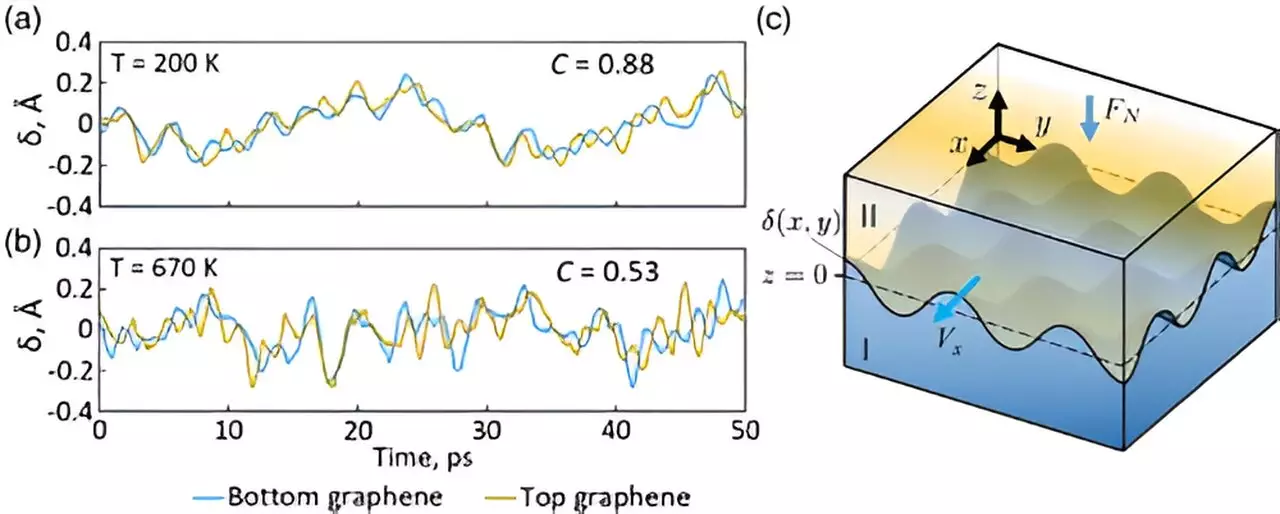Friction is a fundamental force in our everyday lives, dictating how objects interact when in motion. We are all familiar with the principles of regular friction, where the force of friction increases proportionally with the weight of an object. However, scientists at the Skolkovo Institute of Science and Technology (Skoltech) have unraveled the mysteries of ultralow friction, also known as superlubricity, and discovered that it operates under entirely different laws. In their groundbreaking research, the Skoltech researchers identified the unexpected features of superlubricity and provided a novel understanding of its atomic-level mechanisms. These findings have the potential to revolutionize the field of friction and pave the way for energy-saving technologies worldwide.
The team, led by Skoltech Professor Nikolay Brilliantov, set out to investigate the peculiar behavior of superlubric friction. Contrary to our intuition, they found that the weight of a sliding body does not affect the friction force in the realm of superlubricity. Even if you were to increase the weight of an object from one kilogram to several tons, the frictional force would remain unchanged. This phenomenon defies the conventional Amontons-Coulomb friction laws, which have been ingrained in our understanding of friction since their formulation more than 300 years ago. The Skoltech researchers were determined to uncover the underlying mechanics behind this intriguing independence of friction on weight.
To unravel the mysteries of superlubricity, the Skoltech researchers embarked on a multidisciplinary study. The team combined experimental work conducted by Professor Albert Nasibulin’s group, numerical simulations led by Research Scientist Alexey Tsukanov, and the theoretical insights of Professor Brilliantov himself. Through their collaborative efforts, they shed light on the atomistic mechanism responsible for the independence of friction on weight and developed alternative laws of superlubricity that starkly contrast with the Amontons-Coulomb laws.
Superlubricity is closely associated with surfaces that possess an extraordinary smoothness, even at the atomic level. One such example is the carbon-based material graphene. The crux of superlubricity lies in the commensurability, or lack thereof, between the surfaces in contact. If the atomic-level roughness of the surfaces is mutually coherent, the two surfaces lock together, requiring a substantial force to initiate sliding. However, incommensurate surfaces prevent this locking and allow for easy sliding. Nonetheless, even in the realm of superlubricity, friction can still arise due to thermal fluctuations.
The Skoltech researchers discovered that only a specific type of thermal fluctuation is significant – those that occur in sync with the sliding motion. These synchronous fluctuations, known as “surface wrinkles,” play a crucial role in determining the frictional behavior. Surprisingly, these fluctuations require minimal energy and are independent of the weight or normal load of the sliding body. This explains why the frictional force does not change, regardless of the weight of the object. Furthermore, the sliding motion drives these synchronous fluctuations in the direction of motion, dissipating energy as heat and resulting in a dissipative friction force that is proportional to the sliding velocity.
Temperature and contact area also exert a significant influence on superlubricity. Higher temperatures lead to larger amplitudes of synchronous fluctuations, intensifying the dissipative friction force. Similarly, a larger contact area increases the number of surface fluctuations that impede relative motion, thereby augmenting the overall frictional effect. By quantitatively analyzing these factors, the Skoltech researchers were able to formulate new laws that accurately describe superlubricity.
The implications of understanding superlubricity extend far beyond the realm of fundamental science. Controlling and exploiting ultralow friction has the potential to revolutionize energy-saving mechanisms on a global scale. By utilizing the insights gained from the Skoltech research, engineers and scientists can develop novel technologies that minimize friction and reduce energy consumption. From transportation systems to manufacturing processes, the application of ultralow friction principles holds immense promise for a more sustainable and energy-efficient future.
The Skoltech researchers have embarked on an awe-inspiring journey into the world of ultralow friction. Their groundbreaking findings have shattered our preconceived notions of friction and revealed the intricate atomic-level mechanisms that govern superlubricity. Through their collaborative efforts, they have formulated alternative friction laws that challenge the conventional wisdom established over centuries. The potential applications of ultralow friction are vast, ranging from energy-saving technologies to advancements in various industries. As we continue to explore and comprehend the remarkable properties of superlubricity, we move one step closer to a more efficient and sustainable future.



Leave a Reply